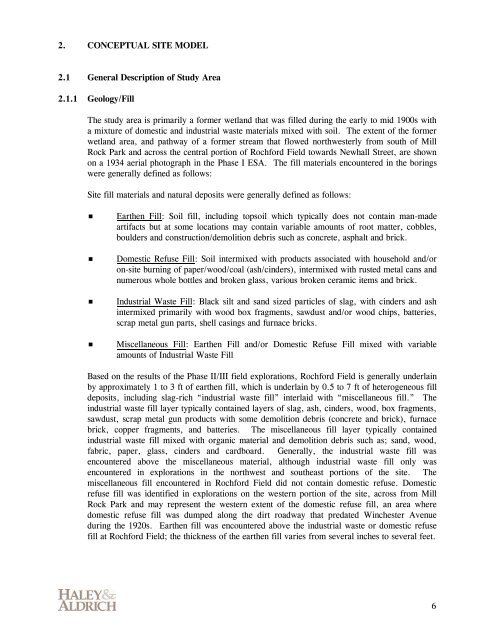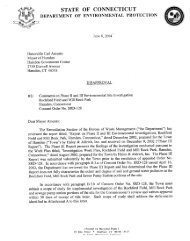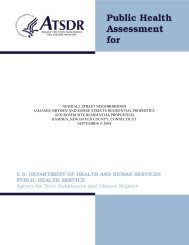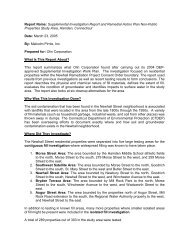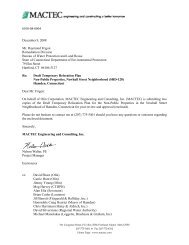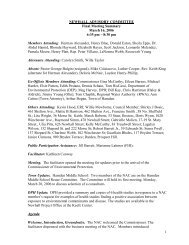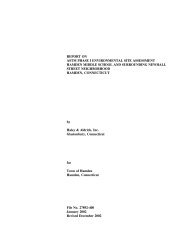Remedial Action Plan - Rochford Field - Newhall Remediation Project
Remedial Action Plan - Rochford Field - Newhall Remediation Project
Remedial Action Plan - Rochford Field - Newhall Remediation Project
Create successful ePaper yourself
Turn your PDF publications into a flip-book with our unique Google optimized e-Paper software.
2. CONCEPTUAL SITE MODEL<br />
2.1 General Description of Study Area<br />
2.1.1 Geology/Fill<br />
The study area is primarily a former wetland that was filled during the early to mid 1900s with<br />
a mixture of domestic and industrial waste materials mixed with soil. The extent of the former<br />
wetland area, and pathway of a former stream that flowed northwesterly from south of Mill<br />
Rock Park and across the central portion of <strong>Rochford</strong> <strong>Field</strong> towards <strong>Newhall</strong> Street, are shown<br />
on a 1934 aerial photograph in the Phase I ESA. The fill materials encountered in the borings<br />
were generally defined as follows:<br />
Site fill materials and natural deposits were generally defined as follows:<br />
<br />
<br />
<br />
<br />
Earthen Fill: Soil fill, including topsoil which typically does not contain man-made<br />
artifacts but at some locations may contain variable amounts of root matter, cobbles,<br />
boulders and construction/demolition debris such as concrete, asphalt and brick.<br />
Domestic Refuse Fill: Soil intermixed with products associated with household and/or<br />
on-site burning of paper/wood/coal (ash/cinders), intermixed with rusted metal cans and<br />
numerous whole bottles and broken glass, various broken ceramic items and brick.<br />
Industrial Waste Fill: Black silt and sand sized particles of slag, with cinders and ash<br />
intermixed primarily with wood box fragments, sawdust and/or wood chips, batteries,<br />
scrap metal gun parts, shell casings and furnace bricks.<br />
Miscellaneous Fill: Earthen Fill and/or Domestic Refuse Fill mixed with variable<br />
amounts of Industrial Waste Fill<br />
Based on the results of the Phase II/III field explorations, <strong>Rochford</strong> <strong>Field</strong> is generally underlain<br />
by approximately 1 to 3 ft of earthen fill, which is underlain by 0.5 to 7 ft of heterogeneous fill<br />
deposits, including slag-rich “industrial waste fill” interlaid with “miscellaneous fill.” The<br />
industrial waste fill layer typically contained layers of slag, ash, cinders, wood, box fragments,<br />
sawdust, scrap metal gun products with some demolition debris (concrete and brick), furnace<br />
brick, copper fragments, and batteries. The miscellaneous fill layer typically contained<br />
industrial waste fill mixed with organic material and demolition debris such as; sand, wood,<br />
fabric, paper, glass, cinders and cardboard. Generally, the industrial waste fill was<br />
encountered above the miscellaneous material, although industrial waste fill only was<br />
encountered in explorations in the northwest and southeast portions of the site. The<br />
miscellaneous fill encountered in <strong>Rochford</strong> <strong>Field</strong> did not contain domestic refuse. Domestic<br />
refuse fill was identified in explorations on the western portion of the site, across from Mill<br />
Rock Park and may represent the western extent of the domestic refuse fill, an area where<br />
domestic refuse fill was dumped along the dirt roadway that predated Winchester Avenue<br />
during the 1920s. Earthen fill was encountered above the industrial waste or domestic refuse<br />
fill at <strong>Rochford</strong> <strong>Field</strong>; the thickness of the earthen fill varies from several inches to several feet.<br />
6


